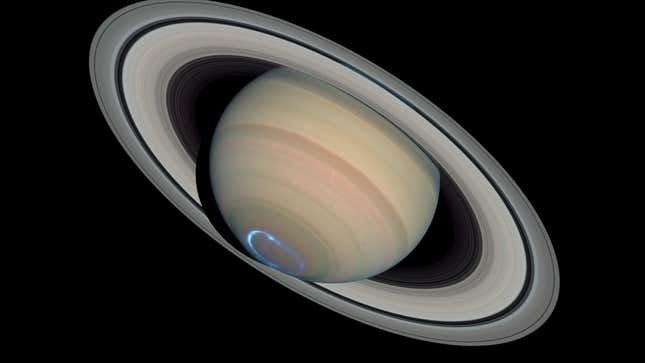
In February, scientists declared that Jupiter had the most moons of any planet in our solar system, with 92 natural satellites, ripping the crown from Saturn’s grasp. Now, Saturn has snatched it back, as astronomers have found an additional 62 objects orbiting the ringed planet, bring its total to a whopping 145 moons.
The announcement is the latest in the back-and-forth between Jupiter and Saturn, two gas giants each with a plethora of moons. A research group led by Edward Ashton, a postdoctoral fellow at Taiwan’s Academia Sinica, recently discovered 62 more moons orbiting Saturn. Ashton’s team used a technique known as “shift and stack” to find any small Saturnian moons that might have eluded astronomers previously. Low and behold, they struck oil, and the newly identified moons have been recognized by the International Astronomical Union, making the Ashton team’s findings—and Saturn’s new record—official.
“Tracking these moons makes me recall playing the kid’s game Dot-to-Dot, because we have to connect the various appearances of these moons in our data with a viable orbit,” said Edward Ashton in a press release, “but with about 100 different games on the same page and you don’t know which dot belongs to which puzzle.”
Ashton and his colleagues used data taken by the Canada-France-Hawaii telescope located atop Mauna Kea in Hawaii between 2019 and 2021 to find these moons using the shift and stack method. They looked at sequential images from the telescope to find moving points. They had to track these objects for several years in the dataset in order to be certain that they were moons and not rogue objects, like asteroids, for example. By viewing the data in three-hour chunks, the team was able to identify moons of Saturn that were as small as 1.5 miles (2.5 kilometers) wide.
Jupiter was dubbed Moon King in February, when the planet lay claim to 92 satellites while Saturn only had 83. Until 2017, Jupiter officially had 67 moons, but between 2017 and 2022, astronomer Scott Sheppard from the Carnegie Institution for Science and his team identified over two dozen more natural satellites. Sheppard told Gizmodo at the time that Saturn and Jupiter have so many moons because they are fragments of once-larger satellites that broke apart due to impacts with asteroids or other moons. While Saturn’s current tally of 145 moons is undoubtedly impressive, it may only be a matter of time until the title shifts hands once again.






